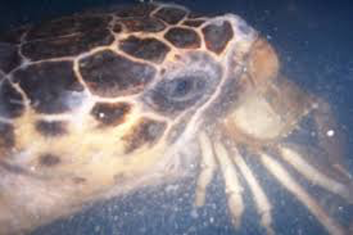|
Blog Post By: Dalton Moore, Sea Turtle Intern
Loggerhead hatchlings are omnivores meaning they consume both animals and plants. Hatchlings will eat a variety of prey, including life-like sargassum seaweed, crustaceans, mollusks, hydrozoans, jellyfish, and fish eggs. After maturity, adults will convert to primary carnivorans, favoring crabs, whelks, and conchs. The loggerhead turtle is named for its large head, which supports powerful jaw muscles that enable them to feed on hard-shelled prey. Using their jaws, an adult loggerhead sea turtle can bite with the force of nearly 500 pounds allowing them to crush their desired meal. The earliest of the seven species appeared on earth approximately 220 million years ago and evolved to hunt successfully beneath the surface. Unfortunately, there is a new item on the menu that is not nutritional. In fact, it is very harmful to not only Loggerheads but all species of sea turtles. That is plastic. Research suggests that 52% of the world's sea turtles have consumed plastic waste. This is simply because floating plastic bags or debris can look a lot like jellyfish, algae, or other species that formulate a significant component of the sea turtles' diets. So, what happens to sea turtles that eat plastics? For approximately 22%, ingesting just one plastic item can be deadly. Bags can cause blockages of the intestines, leaving turtles unable to consume or digest, which may result in starvation. Sharp plastics can rupture internal organs. Even if they survive, consuming plastic can make turtles unnaturally buoyant, stunting their growth and leading to slow reproduction rates. How can we help? With the odds stacked so heavily against sea turtles, it is challenging to take a stand. There are approximately 269,000 tons of plastic within the world's oceans. We need to begin to do our part to reduce plastic pollution by recycling and reducing single-use items. Governments also must step up to take accountability and end or at least mitigate this pollution epidemic. Also, if you discover a dead, sick, or injured sea turtle along South Carolina's coast, please call SCDNR's 24-hour hotline 1-800-922-5431.
0 Comments
Leave a Reply. |
Leah SchwartzentruberSea Turtle Biologist Archives
June 2024
|

 RSS Feed
RSS Feed